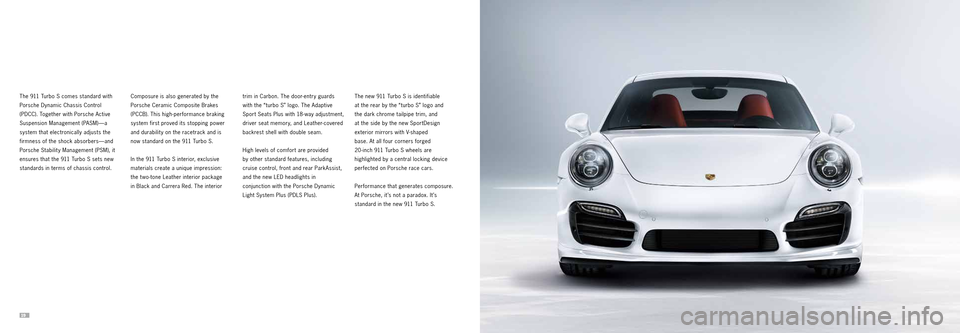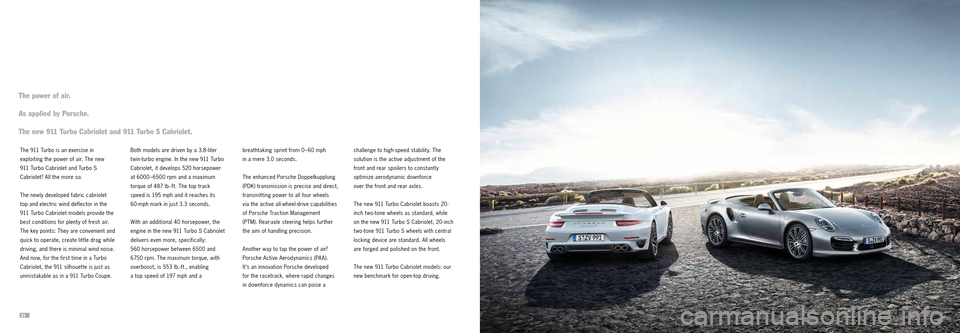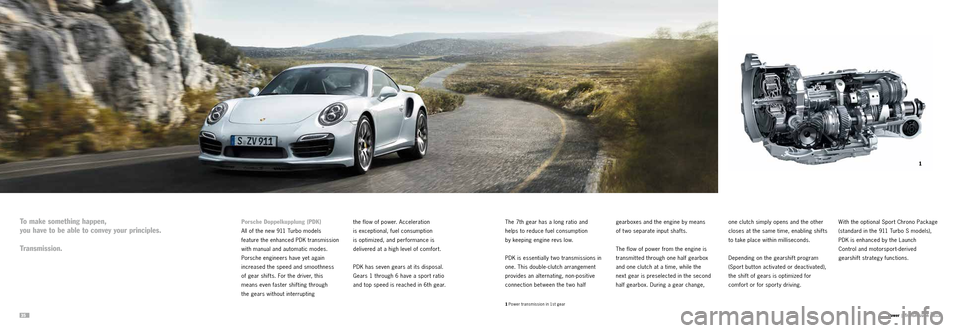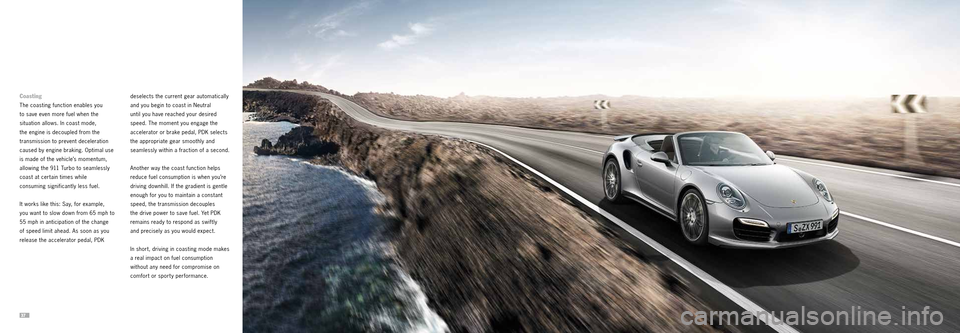PORSCHE 911 TURBO 2013 6.G Information Manual
Manufacturer: PORSCHE, Model Year: 2013, Model line: 911 TURBO, Model: PORSCHE 911 TURBO 2013 6.GPages: 59, PDF Size: 5.96 MB
Page 11 of 59

1920
The 911 Turbo S comes standard with
Porsche Dynamic Chassis Control
(PDCC). Together with Porsche Active
Suspension Management (PASM)—a
system that electronically adjusts the
firmness of the shock absorbers—and
Porsche Stabilit y Management (PSM), it
ensures that the 911 Turbo S sets new
standards in terms of chassis control.Composure is also generated by the
Porsche Ceramic Composite Brakes
(PCCB). This high-performance braking
system first proved its stopping power
and durabilit y on the racetrack and is
now standard on the 911 Turbo S.
In the 911 Turbo S interior, exclusive
materials create a unique impression:
the two-tone Leather interior package
in Black and Carrera Red. The interior trim in Carbon. The door-entry guards
with the “ turbo S” logo. The Adaptive
Sport Seats Plus with 18-way adjustment,
driver seat memory, and Leather-covered
backrest shell with double seam.
High levels of comfort are provided
by other standard features, including
cruise control, front and rear ParkAssist,
and the new LED headlights in
conjunction with the Porsche Dynamic
Light System Plus (PDLS Plus).The new 911 Turbo S is identifiable
at the rear by the “ turbo S” logo and
the dark chrome tailpipe trim, and
at the side by the new SportDesign
exterior mirrors with V-shaped
base. At all four corners forged
20 -inch 911 Turbo S wheels are
highlighted by a central locking device
perfected on Porsche race cars.
Performance that generates composure.
At Porsche, it ’s not a paradox. It ’s
standard in the new 911 Turbo S.
Page 12 of 59

21
The power of air.
As applied by Porsche.
The new 911 Turbo Cabriolet and 911 Turbo S Cabriolet.
The 911 Turbo is an exercise in
exploiting the power of air. The new
911 Turbo Cabriolet and Turbo
S
Cabriolet? All the more so.
The newly developed fabric cabriolet
top and electric wind deflector in the
911 Turbo Cabriolet models provide the
best conditions for plent y of fresh air.
The key points: They are convenient and
quick to operate, create lit tle drag while
driving, and there is minimal wind noise.
And now, for the first time in a Turbo
Cabriolet, the 911 silhouette is just as
unmistakable as in a 911 Turbo Coupe. Both models are driven by a 3.8-liter
t win-turbo engine. In the new 911 Turbo
Cabriolet, it develops 520 horsepower
at 6000 – 6500 rpm and a maximum
torque of 487 lb.-ft. The top track
speed is 195 mph and it reaches its
60 -mph mark in just 3.3 seconds.
With an additional 40 horsepower, the
engine in the new 911 Turbo S Cabriolet
delivers even more, specifically:
560 horsepower bet ween 6500 and
6750 rpm. The maximum torque, with
overboost, is 553 lb.-ft., enabling
a top speed of 197 mph and a breathtaking sprint from 0–60 mph
in a mere 3.0 seconds.
The enhanced Porsche Doppelkupplung
(PDK) transmission is precise and direct,
transmit ting power to all four wheels
via the active all-wheel-drive capabilities
of Porsche Traction Management
(PTM). Rear-axle steering helps further
the aim of handling precision.
Another way to tap the power of air?
Porsche Active Aerodynamics (PA A).
It ’s an innovation Porsche developed
for the racetrack, where rapid changes
in downforce dynamics can poise a challenge to high-speed stabilit y. The
solution is the active adjustment of the
front and rear spoilers to constantly
optimize aerodynamic downforce
over the front and rear axles.
The new 911 Turbo Cabriolet boasts 20 -
inch two-tone wheels as standard, while
on the new 911 Turbo S Cabriolet, 20 -inch
t wo -tone 911 Turbo S wheels with central
locking device are standard. All wheels
are forged and polished on the front.
The new 911 Turbo Cabriolet models: our
new benchmark for open-top driving.
Page 13 of 59

24
Cabriolet Top
The fabric roof in the new 911 Turbo
Cabriolet models has been completely
revised. It uses three integrated
supporting elements made from
magnesium. Light yet strong, the
magnesium components make the top
extremely stable at high speeds—
without adding unnecessary weight.
The magnesium structure also creates a
top that is smooth and taut. The fabric
is close-fit ting and forms a line that is
even more elegant than in the previous
model. Yet the benefit is far from being
just superficial. The firm fabric roof of the
new 911 Turbo Cabriolet models helps
achieve a drag coefficient of just 0.31. The glass rear window is
scratch-re
sistant and heated. A
water
-de
flecting edge on the top
helps prevent rainwater from dripping
onto you when you open the doors.
The top is operated electrically by
a but ton in the center console, and
it opens or closes in approximately
13 seconds—at speeds of up to
31 mph. The top folds in a Z-shape so
the inside is always well-protected.
Inside, the roof is covered with
heat- and noise-insulating material,
resulting in uniform interior
temperatures and effective wind
noise suppression. What do you hear
instead? That unmistakable sound of
the Porsche Turbo exhaust note.
Electric Wind Deflector
Developed in a wind tunnel and made
for relative wind: The 911 Turbo
Cabriolet models come standard with
a new electric wind deflector. This
ensures that you can drive with the
top down with minimal wind noise,
and without sacrificing the car’s low
drag coefficient. You can extend and
retract the wind deflector at speeds
of up to 75 mph—at the press of a
but ton and in only t wo seconds. Manually fit ting and removing the wind
deflector is no longer necessary. It is
now integrated directly into the body and
rests behind the back seats, so it does
not need any additional space inside the
vehicle or in the luggage compartment
and is ready to use at any time.
911 Tu r b o | The new 911 Turbo Cabriolet and 911 Turbo S Cabriolet
Page 14 of 59

2526
Po w e r.
For Porsche, power and weight have always been viewed as part of the
same equation. Turbocharging is a way to create a dramatic increase in
power, without adding the bulk of a big displacement engine. And then
there is the question of where to place the engine’s mass. In the new
911
T
urbo, it is where you’d expect Porsche to put it: at the rear.
Together with countless other innovations, these two fundamental
aspects of the 911 Turbo—its turbocharged power, rear-mounted—
create a performance character for which there simply is no substitute.
Page 15 of 59

2728 Power | Engine
The new 911 Turbo engine adheres
to proven Porsche principles: rear-
mounted. With six cylinders and a total
displacement of 3.8 liters. And the
cylinders placed horizontally in two
opposite rows—what ’s referred to as
a “ flat-six” arrangement. It does not
deviate from this formula because the
typical Porsche “boxer” construction
and the rear-mounted position of the
engine create numerous advantages:
excellent balancing of masses as
dynamic loads change, a low-vibration
drive, and a low center of gravit y. But what ultimately transforms a Porsche
into a 911 Turbo are its t wo exhaust-
driven turbochargers. Together with
Variable Turbine Geometry (VTG), the
intake manifold, and VarioCam Plus,
the forced induction of compressed
air into the cylinders creates stunning
performance. On paper or on pavement,
there is nothing like a Porsche 911 Turbo.
The new 911 Turbo and the
new 911 Turbo Cabriolet deliver
520 horsepower available between
6000 and 6500 rpm, and 487 lb.-ft. of torque bet ween 1950 and 5000 rpm
(a
nd briefly up to 524 lb.-ft. with the
overboost function that comes with
the optional Sport Chrono Package).
The 911 Turbo S models have
560 horsepower available between
6500 and 6750 rpm. The maximum
torque is 516 lb.-ft., from 2100 –4250 rpm.
And it can increase to 553 lb.-ft., thanks
to the overboost function that comes
with the Sport Chrono Package, which
is standard on Turbo S models. This is efficient performance, thanks
to intelligent innovations that keep
the vehicle weight low and make
optimal use of fuel. These include new
efficiency-enhancing measures such as
thermal management, electrical system
recuperation, the Auto Start Stop
function, and the coasting function.
The essential ingredients are familiar.
Yet transformation is phenomenal.
Engine.
Page 16 of 59

2930 Power | Engine
Both versions of the new engine have
Direct Fuel Injection (DFI). DFI injects
the fuel directly into the combustion
chamber with millisecond precision.
Injection and taper angle are optimized
for torque, performance, consumption,
and emissions. The engine control
system adjusts the injection timing
individually for each cylinder and the
injection quantit y for each cylinder
bank. The greater compression this achieves provides more power—and
makes the engine more efficient.
The integrated dry-sump lubrication
ensures reliable oil supply and also
performs additional cooling functions.
The electronic oil pump supplies oil
when it is needed. And because the oil
reservoir is integrated in the engine,
there is no need for an external oil tank.
This saves space and, above all, weight.
The 3.8-liter, 6-cylinder boxer engine
is made with a light weight alloy
design. The engine’s impressive
power-to-weight ratio increases
agilit y and optimizes fuel efficiency. The connecting rods and aluminum
pistons are forged for added
strength, and each piston is
individually cooled by oil injection
nozzles in each cylinder. The cylinders are made from an aluminum alloy
that offers exceptional resistance
to the punishing heat generated
by a high-performance engine.
The result—for you, and for the
911 Turbo driving experience—
is an engine with extraordinary
power and surprisingly low
consumption, especially when
compared to engines with
greater displacement.
911 Turbo S an d 911 Turbo S Cabriolet:
516 lb.-f t. bet ween 2100 and 4250 rpm, 560 horsepower bet ween 6500 and 6750 rpm
911
Tu
rbo and 911 Turbo Cabriolet:
487 lb.-f t. bet ween 1950 and 5000 rpm, 520 horsepower bet ween 6000 and 6500 rpm
637
603 570
536 503 469
436
402 369
335 302
268 235 20116 8
13 4 101 67
34 0
100015 0 0200025003000350040004500500055006000650070007500 568
546 524
502 479
457
435 413
391
369 3 47
325
302
280 258
236 214
192 17 0
14 8
Torque (lb.-ft.) Power (hp)
Engine Speed (rpm)
520 hp487 lb.-ft.
524 lb.-ft. overboost
637
603 570
536 503 469
436
402 369
335 302
268 235 20116 8
13 4 101 67
34 0
100015 0 0200025003000350040004500500055006000650070007500 568
546 524
502 479
457
435 413
391
369 3 47
325
302
280 258
236 214
192 17 0
14 8
Torque (lb.-ft.) Power (hp)
Engine Speed (rpm)
560 hp)516 lb.-f t .
553 lb.-ft. overboost
Page 17 of 59

32
1
2
3
4
Power | Engine
Variable Turbine Geometry (VTG)
One of the critical factors in designing a
turbocharged engine has always been the
size of the turbo units. Large turbines
create massive boost, but suffer “ turbo
lag” as they begin to spool up. Smaller
turbines respond more quickly, but lack
the capacit y to induce large amounts
of exhaust air. With Variable Turbine
Geometry (VTG), Porsche engineers
have resolved this conflict. As exhaust
flow from the engine is channeled into
the turbines, the engine management
system controls the electronically
adjustable guide vanes, changing the
vane angle so the system can replicate
the advantages of both sizes of turbo,
large and small. The optimal gas-flow
characteristics are achieved at all times. This results in a high turbine speed—
and greater boost pressure—even
at low engine rpm. With more air
available, the combustion is increased,
yielding bet ter power and torque. The
torque curve reaches its maximum
level much sooner—and stays there.
V TG also improves the response
of the turbo engine with dynamic
boost pressure development.
When the boost pressure reaches
its maximum value, the guide vanes
are opened further. By varying the
vane angle, it is possible to achieve
the required boost pressure over the
entire engine-speed range, so excess
pressure valves are no longer required.
Porsche revolutionized the modern
sports car with the original 911 Turbo.
And with innovations such as Variable
Turbine Geometry (VTG) in the new
911 Turbo, the revolution carries on.
VarioCam Plus
VarioCam Plus is a two-in-one engine
concept that adjusts the camshafts on
the intake side and controls valve lift.
The system distinguishes bet ween
normal everyday driving and maximum
power requirements and adapts to
the corresponding conditions. The
switchover is performed imperceptibly
by the electronic engine management
system. The result is spontaneous
acceleration, an extremely quiet drive,
and extraordinary engine power with
comparatively low fuel consumption. press as much of the air/fuel mixture as
possible into the cylinders. But added
compression not only increases air
volume—it also raises air temperature.
And this has a negative effect on ignition.
The 911 Turbo model’s expansion
manifold turns that principle around. The
internal geometry is radically different
from that of a resonance intake system.
Key modifications include a longer
distributor pipe with a smaller diameter,
and shorter intake pipes. As a result,
the air is in the expansion phase as it
enters the combustion chambers.
Since expansion always cools, the air/
fuel temperature is lower, ignition is
significantly improved, and—here’s the
best part—performance is increased.
Expansion Intake Manifold
More power using less fuel. Sounds
paradoxical, but it ’s really quite simple.
You just have to question the norm.
Take the intake manifold in the new
911 Turbo models, as an example. With
a traditional resonance manifold, more
air means more power. The compression
effect in the intake system is used to The amount of air that enters the engine
under expansion is less than it would
be under compression. To compensate
for this, Porsche engineers simply
increased the boost pressure. The
resulting increase in temperature—again
through compression—is immediately
offset by the uprated intercoolers.
Instead of hot compressed air entering
the combustion chambers, the cooler
air generates more power and torque.
As a consequence, there is a major
improvement in engine efficiency.
Fuel consumption is lower, even under
heav y loads and at high revs.
4 VarioCam Plus4
1 Vanes closed | 2 Vanes open | 3 Variable Turbine Geometry (VTG)
Page 18 of 59

3334
Thermal Management
The thermal management system
regulates the temperature in the engine
and transmission through the intelligent
manipulation of heat flow. It allows the
engine and transmission to reach their
optimal operating temperatures sooner.
The result? Combustion efficiency and
lubrication performance are improved,
and fuel consumption is reduced.
Auto Start Stop Function
The Auto Start Stop function is standard
in the new 911 Turbo models. When
the speed falls below 4 mph and the
911 Turbo is decelerating normally, the
engine switches off. For example, as you
are slowing while approaching a red light.
Audio and communication systems
remain switched on. The climate
control continues to maintain your
selected temperature. The engine
starts again when you release the
brake or move the steering wheel.
The Auto Start Stop function may remain
inactive under particular circumstances,
for example if the bat tery charge is
low, when the Sport but ton is selected,
or when there are extreme outside
temperatures. It is also possible to
deactivate the function manually using a
separate button on the center console.
Electrical System Recuperation
Another fuel-saving innovation that’s
standard on the new 911 Turbo models
is electrical system recuperation
technology. It captures the energy
created during events such as braking.
The vehicle bat tery is recharged by
the alternator, predominantly under
braking. Under acceleration, on the
other hand, the power draw of the
alternator is limited to increase the
engine output available for driving.
The electrical systems are supplied
by the electrical energy stored
during the recharging process.
Page 19 of 59

3536 Power | Transmission
To make something happen,
you have to be able to convey your principles.
Transmission.
1 Power transmission in 1st gear
Porsche Doppelkupplung (PDK)
All of the new 911 Turbo models
feature the enhanced PDK transmission
with manual and automatic modes.
Porsche engineers have yet again
increased the speed and smoothness
of gear shifts. For the driver, this
means even faster shifting through
the gears without interrupting the flow of power. Acceleration
is exceptional, fuel consumption
is optimized, and performance is
delivered at a high level of comfort.
PDK has seven gears at its disposal.
Gears 1 through 6 have a sport ratio
and top speed is reached in 6th gear.
The 7th gear has a long ratio and
helps to reduce fuel consumption
by keeping engine revs low.
PDK is essentially t wo transmissions in
one. This double-clutch arrangement
provides an alternating, non-positive
connection between the two half gearboxes and the engine by means
of t wo separate input shafts.
The flow of power from the engine is
transmit ted through one half gearbox
and one clutch at a time, while the
next gear is preselected in the second
half gearbox. During a gear change, one clutch simply opens and the other
closes at the same time, enabling shifts
to take place within milliseconds.
Depending on the gearshift program
(Sport button activated or deactivated),
the shift of gears is optimized for
comfort or for sporty driving.With the optional Sport Chrono Package
(standard in the 911 Turbo S models),
PDK is enhanced by the Launch
Control and motorsport-derived
gearshift strategy functions.
1
Page 20 of 59

3738
Coasting
The coasting function enables you
to save even more fuel when the
situation allows. In coast mode,
the engine is decoupled from the
transmission to prevent deceleration
caused by engine braking. Optimal use
is made of the vehicle’s momentum,
allowing the 911 Turbo to seamlessly
coast at certain times while
consuming significantly less fuel.
It works like this: Say, for example,
you want to slow down from 65 mph to
55 mph in anticipation of the change
of speed limit ahead. As soon as you
release the accelerator pedal, PDK deselects the current gear automatically
and you begin to coast in Neutral
until you have reached your desired
speed. The moment you engage the
accelerator or brake pedal, PDK selects
the appropriate gear smoothly and
seamlessly within a fraction of a second.
Another way the coast function helps
reduce fuel consumption is when you’re
driving downhill. If the gradient is gentle
enough for you to maintain a constant
speed, the transmission decouples
the drive power to save fuel. Yet PDK
remains ready to respond as swiftly
and precisely as you would expect.
In short, driving in coasting mode makes
a real impact on fuel consumption
without any need for compromise on
comfort or sporty performance.